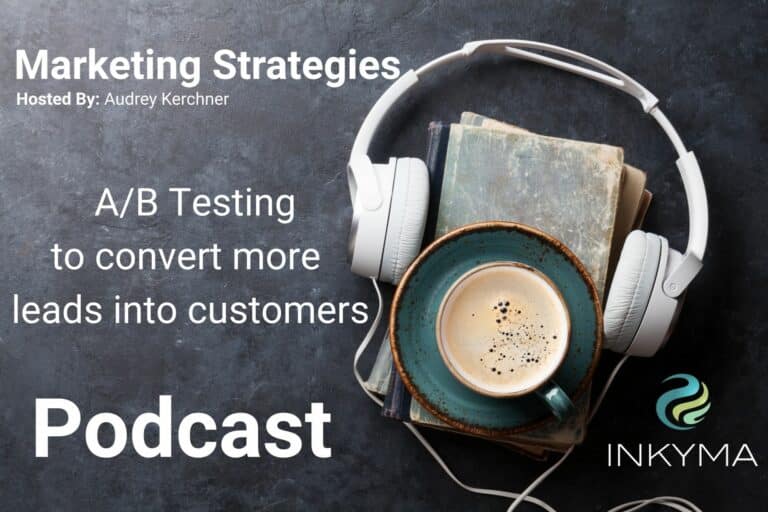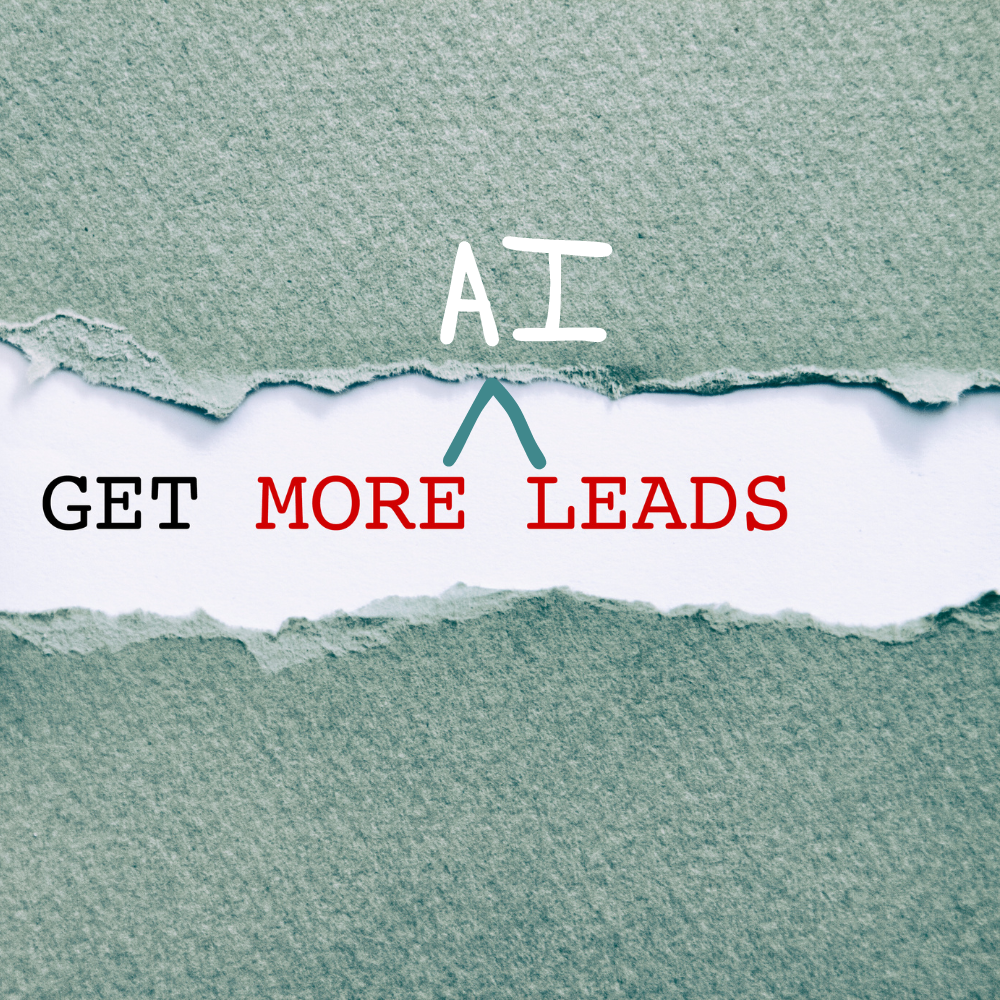Split Testing, also known as A/B Testing, converts more leads to clients. When performed properly, this advanced concept can help you convert better qualified and quality leads into clients over a selected period of time. Join Audrey while she explains the basic best practices to start mastering this marketing strategy.
Links Mentioned In This Episode
E18 Convert Leads into customers with Landing Pages
A/B Testing to Convert More Leads Into Customers Transcription
A/B testing is pretty time-consuming and complex, even with all the tools that are available to us today. And this episode just really gives you the basics. So you can start. So that you can understand, “Yeah, this is something I need to take on.”
Welcome to Marketing Strategies with Audrey Kerchner, sponsored by INKYMA. Taking your small business to the next level with proven creative solutions designed to grow your awareness and connect to your customers. Now, here’s Audrey.
Hi there and welcome. My name’s Audrey Kerchner and I am the co-founder and chief marketing strategist at Inkyma. Inkyma is a full-service marketing agency, and we bring that big agency process, service, and feel to small business owners. We do marketing strategy, branding, website design and hosting, content marketing, search engine optimization, social media, and digital advertising. To learn more about what we do, ask a question or schedule a marketing evaluation for your business. Go to our website, inkyma.com. That’s I-N-K-Y-M-A .com. If you’re a new or returning listener, welcome. I appreciate everybody tuning in and wanting to learn more about marketing their business. We have many previous shows that teach you about different things. So go to your favorite podcast platform, we’re on pretty much all of them. And then in the search, just type Inkyma, and Marketing Strategies will pop up for you.
So this week, we’re going to talk about A/B testing and how it can help you convert more leads into customers. In marketing, you want leads to become clients by taking a specific action when you launch a marketing campaign. “Buy this. Sign up for that. Schedule an appointment.” Those are all calls to action, those are all the things you want people to do. Where you put those calls to action, what you say, the language you use, the images you use, the video, that’s really important in the conversion process. But how do you know what to choose to get people to convert? To get them to actually take that action, to click on that button, to watch the video, to make the schedule? That’s where A/B testing comes in, and that’s what we’re going to talk about today. But before we do that, I want to talk a little bit about what conversion is, why increasing your conversion is important.
Because A/B testing is a lot of work. And at some point, you may ask yourself, “Why am I doing this?” I want to make sure you really understand the importance, not of just A/B testing, but the importance of conversion when you’re actually doing a marketing campaign. So let’s say you have a hundred people that are served up your ad, your website page, your email, whatever. Whatever the campaign is. And 10 of those people click through, and they sign up. That’s a conversion. Each person who sees it, that takes the action, is considered a conversion. So now the question you have to ask yourself, is do you want more people to sign up? Let’s say you only had five people sign up and you really wanted 10, that’s one question. The other question, is quality versus quantity. So let’s say you had those 100 people see your campaign, but you were giving away a Starbucks gift card, and all 100 signed up for it.
All 100 of those people don’t want or need your services, what they wanted was the gift card. So you have to ask yourself, was that the right offer to give away? And that’s quality versus quantity. You want the right people to sign up and take action. Not just anyone, because that’s just a waste of your time and your money. So this is what conversion is, getting the right people at the right time to take the action that you want. If that’s important to you, then you should be extremely interested in A/B testing.
So let’s talk about what A/B testing is. A/B testing, or sometimes even called split testing, is when you run or show two options in an identical campaign, to see which one gets better actions. And so those options could be a piece of design, a layout change, copy change, video color, all sorts of things. In order to find out which one’s going to get more conversions, whether it’s quality or quantity. So in the example I gave before of quality, you weren’t getting high quality because the giveaway belonged to… Anybody would be happy with that giveaway. Versus if you did a giveaway that was very specific to your target audience, like a checklist. Something that they need because they’re in your buying process. And so you could test the two. So now, I want to share with you a clip from a previous show where one of the folks that I interviewed, talked about how they use A/B testing.
“So the most basic example for A/B testing, is let’s say we’ve got a home with a pool table and another photo of a hot tub. We’re going to be taking those two photos from that home, and we’re going to be playing with where they sit on the listing when the guest is looking for that listing online. So are more people clicking on images of hot tubs? Are we seeing people click on more images of a wooded cabin experience? Are we seeing people clicking on homes that have a shot of the downtown area? So it’s putting two options in front of people and seeing which one is most chosen, and then inserting a different variable in there. So A, B. Okay, A is more frequently clicked. Let’s see how it compares up against another type of picture. And it’s just kind of this back and forth of seeing what bait do you put on your hook to get a fish?”
So hopefully that helped sum up what A/B testing is. And I think Kilian really summed it up nicely. So now, let’s talk about the benefits of A/B testing and how it actually improves lead conversion. You always want to make marketing decisions based off of data, right? What you get as feedback. You can always start with assumptions or what you think. But ultimately, to really hone things in, you need data. And with A/B testing, you need larger data sets. Think of it as a focus group, but you don’t have the people in the room and sitting down with you. And ideally, what you want, are people that are part of your target audience as part of that testing data. So asking friends, colleagues, family, it’s okay to ask them what they think, but ultimately, they’re not your target audience. They’re not the ones that are going to buy from you day in and day out. And they’re really small. So you need to have a decent size focus group, and that’s where A/B testing comes in. That’s one of the benefits you get to test against a lot of people.
The second thing, is — I’ve been doing this for a very, very long time. 20, 25 years marketing, all this great stuff. So we know in general, what marketing tactics work, what are best practices for design, layout, copy. But you know what? Every business is different, every audience for that particular business is different. You can give me three businesses in the same industry and their audiences are going to be slightly different from each other. And how they talk to them is going to be different. And then the other thing that’s different, is what’s going on in the world? And what part of the country are you in? Those are those different factors.
So while we can generally say this type of campaign works with this type of language, A/B testing allows you to hone that message down. So you’re getting the right message, at the right time, to the right audience to increase conversion. So a couple of examples of this differentiation, is one that we all know really well unfortunately, is the pandemic. When this pandemic hit, all of the stuff I knew and my team knew about marketing, kind of went out the window. We had to start from scratch with market research and testing. Because all the messaging for every client across the board changed, safety became a huge factor in messaging. Regardless if you were grooming dogs, cleaning homes, or serving people food. So instead of delicious food, it was like, “Come to our restaurant because it was safe.” And we had to rewrite tons and tons of copy, and retest a bunch of stuff.
The other option that is still relevant today and will always be relevant is, are you a national company providing this service or regional? Or are you hyper-local? So if you take the example of a cleaning company, let’s say you work in a county in a state. You’re messaging is going to be highly different than a regional, three-state company who does the exact same thing you do. Your audience is different, and so you’re going to be testing different things. So while it may be the same campaign, same general message, those little details are going to be very, very different. So where do you use A/B testing? I always get that question. “Where do I do this?” So the general answer is, you can use this on any campaign that you put out there. If you’re making pens, you can make two different kinds of pens and test them.
I had a client, he made giveaway stickers, and we made three different kinds and we’re checking to see which one. But for the purpose of keeping our podcast in a frame, I’m going to talk about the top three that you’re going to use them in, them being tactics, to generate conversions. So the first one is website pages, landing pages. And if you’re unfamiliar with landing pages, go and listen to episode 18 where I talk about landing pages, how to create them, the best way to lay things out in general, before you start testing. So the types of things you can test on a website page or a landing page, is the call to action language, that bi-language, that sign-up language, videos, hero images, and that copy that goes in that. A hero image is that very first big, beautiful image that shows up at the top of a page and the language that supports it. Because when you get to the page, that’s the first thing you see before any movement starts to happen.
Button colors. That color is really important catching the eye, making sure it’s a color that works for your brand. Form design. You can have too much in a form, which would keep people from filling it out and signing it up. Or you can have too little, where you don’t have enough information to see if they’re a qualified lead or not. So how many input fields that you need. The next one are email campaigns. So it doesn’t matter if it’s a newsletter, a sales funnel, a single campaign that goes out with an offer to a subset of a group. These are things be tested. Subject lines. For email, subjects lines are the number one thing that people test. Because that subject line is what people use to decide if they’re going to open the email or not, and learn more. From name. Who it’s from can decide whether or not they’re going to open it. Adding any type of personalization, put the recipient’s name in there at the top, in the middle, near the bottom for emphasis to get people do what you’re asking them to do.
And then very similar items that you would put on the website. You can add video, you can add pictures, what picture where, and then placement of all of these different things can be tested. And probably now, the number one thing that people would be the most familiar with the concept of A/B testing, are digital ads. Whenever you read articles about digital ads or talk about it, anybody that really understands the concept will say, “You need to test things.” Because you’re spending a lot of money with digital ads. And so you want to ensure that the right message is getting to the right people. So headlines, descriptions, images, videos, call to action language. Not so much where stuff goes, because that’s really decided on who you’re doing the digital ad with. So if you’re doing a Google ad versus a Facebook ad, versus Instagram, there is only so many places things can go and you don’t get to decide that. What you get to decide, is the content of what goes there.
And in some cases, the color of buttons or the supporting colors, in the instance of Google. So the good news, is that many of these software platforms for websites, for email, especially for digital advertising, they have A/B testing built in. Meaning you don’t have to create two different versions, and then launch them separately. A lot of them have incorporated that, because they understand that people want to be able to A/B test a lot of these different things. So for websites, because we’re a WordPress shop, that is what we know. WordPress has plugins that will help you A/B test two different versions of a homepage or two different versions of a landing page. So when the person goes to that page, the system, because of the plugin, will randomize which one they see and then provide you data back on what they did. So you can decide what items on the elements on the page people are responding to better.
Email systems. There’s a ton of email systems out there. We use mail Mailchimp. We are certified partners with Mailchimp and they do A/B testing. So you can create two different versions of an email and say, “Randomly select who gets what of this test, one or two.” And they send it out and they give you the results to compare. And then Google and Facebook, those are the top two digital ad platforms. I’m not going to talk about any others, but both of them have A/B testing built in. And they make it much, much easier than any other system to compare. Not only do they do that, but they allow you to have multiples in there. So you can have five headlines, five descriptions. They’ll go through and create all the different variations, send them out, and then decide which ones the winner and tell you what to do more of.
And then they’ll even recommend– like Google, recommend this image isn’t doing so well of the five or six that you chose. Let’s replace it out and add a new one in the mix. So that as you continue to do ads, they’ll continue to constantly be doing the A/B testing on your behalf. So now that you know what it is, where you can use it, let’s talk about some best practices so you can get started with A/B testing.
You’re listening to Marketing Strategies and I’m Audrey Kerchner. We’re talking about A/B testing and how using it can convert more leads into customers. If you have a marketing question or a topic that you want me to talk about, you can submit it on the website at inkyma.com. That’s I-N-K-Y-M-A .com. And scroll down to the contact form, put everything in there, and it’ll come right to me.
Figuring out and learning how to do A/B testing, it’s a big topic. It’s a big thing. So instead of trying to walk you through the process, I’m going to give you some best practices for A/B testing. So regardless of what method you choose to start out with, these are some things you’re going to have to do no matter what. Regardless if it’s a website, an email campaign, or even the digital marketing piece. So the first thing I want you to do, is you only test one thing at a time. So let’s say you have two web pages, one and two, A and B. Pick an image, which do you think will be better? That’s what you test. Because if you test multiple things at the same time and you come up with a page that does better, you don’t know why it’s better. And you need to know why it’s better, because at some point in the future, you are probably going to have to change that landing page or change that email campaign, and you’re not going to know what to pull forward.
Introducing too many variables muddies the water of what was right and what was wrong. The exception here, as I mentioned earlier in the episode, is Google and Facebook ads because they track all of that. Their software is built to do this highly randomized A/B testing. In the past, you used to have to just change one variable out. But now that the systems have it built in, you can have five descriptions. You can have five images, you can have five different headlines. And then constantly have them rotating out. But for everything else, pick one thing and test that. And then when you figure it out which one’s better, you can then test something else.
Second best practice, is pick the right sample size. Make sure you’re sending it to a large enough audience for your business, to ensure that you’re going to get good results. If your company is very niche, very small, your audience size is going to be smaller than someone who’s a national brand and they service pretty much anyone. Like if they’re a shoe company, their data set size is going to be larger. So that’s why I say, pick what works for your industry and what you do. The nice thing is, is if you’re using a system that has A/B testing built in, you can usually send something to your entire audience. And then it will do all the split for you, so you don’t have to pick a small piece of the audience.
This may be a little different if you’re trying to launch a one-time campaign. Let’s say, you’re doing an email, it’s a special offer. It’s going to a specific group and you want to A/B test it. Then, start with the rule of thumb, of 10 to 15% of your entire audience as your sample size. The nice thing about that, is you can actually resend the winner to the ones that didn’t get the winner before as part of that, when you launched the full campaign.
Number three, know why you’re testing something. This seems like it would be a bit of a no-brainer, but I think understanding why you’ve decided to test something is really important. Almost like posing a question to yourself. And I want to use the Hoste example that we heard earlier. They wanted to know what specific feature would make someone want to pick the renting listing, a pool table or a hot tub? Which one’s going to make them click? That was the question that they asked themselves. So make sure you ask yourself a question and not just test things randomly.
And then to follow that up, make sure that there’s enough contrast between the two images. A lot of times, people will test things that are too similar. Is the woman in the red sweater, better than the woman in the blue sweater? That’s too, too, too close. You’re not going to get really good results, so make sure it’s high contrast. Like the pool table versus the hot tub. Make sure you ask yourself the question first, and then pick something that is uniquely different.
The fourth one, I see this all the time, is people rush results. Pick a test duration and stick with it. Don’t make changes while you’re testing or waiting for results to come back. So you put stuff out there, and campaigns need time to run. People get excited. They see ones kind of doing better, but if you let it go for the total duration, you might see different results. So here are some guidelines for the top three that I mentioned earlier, homepage or a website page. If you’re using search engine optimization, give it a month or two, you need time for people to organically hit that page in order to find out which one is better. Organic finding and searching, it just takes time.
Email campaigns. I would say, give it a full week. Even though it goes out on a Monday, not everybody opens it on a Monday. Some people might be away. They might not be able to get to that part of their email until Wednesday or Thursday. So you’ll see initial results come in within the first 24 hours, but let it go for the full duration. Same thing with digital ads. General industry where people are like really churning this stuff over, they’re saying 72 hours. 48 to 72 hours. I like five days. And the reason I like five days, is that people’s behavior changes throughout the week. They’re behaving differently Monday through Friday, than they are maybe Thursday, Friday, Saturday, Sunday. Versus Saturday, Sunday, Monday. So giving yourself a full five days and figuring out what day you should launch on, depending on what you’re doing. So if your audience is really keyed into your product or service on a weekend, launch on a weekend, not a Monday. But give yourself a full five days, because people do things differently. They pay attention differently depending on the day of the week.
And the last best practice that I’m going to share with you, is you’ve got to repeat testing. This is not a one and done type of thing. You may need to test different elements. So if you go back to number one, where I talked about only testing one thing at a time, great. You tested the image, you figured out which one you want. Now, let’s test a subject line or some hero copy to go with it. And then you’ve got to repeat the test. So when you commit to A/B testing for your marketing, realize that you’re committing to retesting and testing over and over again. And, again, I talked about this earlier. Social and society events affect the way people see and react to your marketing. So be aware of what’s going on in the world. You may have tested something three months ago and now it’s not performing as well. What’s changed? Has your market changed? Has the world changed? Is it a different time of year? You’ve got to look at those things.
So hopefully now, I have you all excited about taking on the journey of A/B testing. So let’s talk about some actions that you need to take to make that next step, because all this information’s great unless you actually do something with it. So the first action I want you to do, is pick a single tactic that you’re already doing in your business, a marketing tactic that you’re already familiar with, and start creating an A/B testing plan for that. It’s far easier to do it to something that you already know if you’re just starting out. Rather than creating a whole new campaign, and then trying to figure out an A/B testing plan for that campaign. Number two, decide what your goal is and what you’re going to be testing. Remember, pick one thing at a time to test. Test images, test language, email subjects, and make sure that they’re not similar. Give them enough contrast. If it’s a subject line, don’t just change one word in the subject line, that’s too minute. Number three, make sure you understand the software, the system that you’re using for this campaign, and the built in A/B testing features and benefits it provides. That’s going to be your best friend. A/B testing from scratch like we used to do in the old days, is really time consuming and very, very fiddly is the best way I can describe it. And it’s not for the faint of heart. So use the tools that they’ve created for you today.
Number four, set up your first A/B campaign and let it run for a specific timeframe. And don’t mark a winner until that timeframe has come. Number five, analyze your data. You’re doing all this work, you’ve let it run the full-time, and you’ve got the data, make sure you look at the data to figure out who won. And then you decide if you want to test something else within that. Let’s say you started out with a picture. You’re like, “Great. I have my winning picture. Now, let’s test a headline.” Test that headline against the winning picture, stack your successes as they go. Because then when you get through with testing four or five different things, you’re going to have a really solid foundation of what actually is going to work for you.
Number six, continue to check your results. When things start to underperform, it’s time to test again. Or, look at the time of year it is. Let’s say you’re a gym, your ads are going to do so much different during the holiday season versus after the holiday season. So during November and December, nobody wants to talk to a gym. No one’s looking at a gym, they’re all looking at holiday snacks. But come January, then you’re the star of the show. So make sure if you start seeing your campaigns go down, don’t assume that you need to retest. Take a look at what’s going on at that moment in time first.
And here’s some final thoughts for you. First, don’t get nuts about testing. You can really get caught up in this in testing nine and 10 different things, or testing every single week. Do just enough to make sure your campaigns are effective. You may need to retest once a quarter, or test four or five different things. Another thing to consider, is most of your static pages on your website, once you test them and get them solid, you really won’t need to retest them. Not unless you add services, change services, or there are huge things that go on in the world that affect every industry, like a global pandemic. That’s when everything needs to be re-looked at again. So I’ll leave you with A/B testing is pretty time consuming and complex, even with all the tools that are available to us today. And this episode just really gives you the basics. So you can start. So that you can understand, “Yeah, this is something I need to take on.” It’s an advanced concept, too. It takes time and practice, but it can be mastered by any business owner. You’ve mastered all the really other hard stuff. This is something you’ve can master too, but it takes time.
So if you don’t want to take that time, you can consider hiring an agency to do all of this for you. An agency can come in, not only create your campaigns, create the A/B testing plan, give you the results, and talk through it with you. So that you are A/B testing everything that you’re doing for your marketing, and that you’re not wasting money. And you’re getting more conversions from all of your campaigns.
Here at Inkyma, we like to give back to the business community. I provide a free 45-minute marketing consultation to anyone. Regardless, if you’re looking for a marketing company, you’re looking for someone to talk to about A/B testing, or how to set up a campaign initially. Just go to my website inkyma.com. That’s I-N-K-Y-M-A .com, and click on the button in the upper right hand corner to schedule a marketing evaluation. Pick your time, and we’re on the calendar. Or if you just have a question or you want to suggest an episode for the podcast, there’s a contact form in the bottom of the page. Go ahead and fill that out as well. I hope you found this information helpful. And if you think you know other business owners that would find this helpful too, please share the episode. You can share it from where you listen to your favorite podcast or you can have them go to our website. Every single podcast is on our website and we’re also on YouTube as well. So you can give it to them where they want to listen. Sharing helps the entire business community and that’s what this podcast is all about. Thanks for listening and have an amazing day.
Thanks for listening to Marketing Strategies, sponsored by INKYMA. Online at I-N-K-Y-M-A .com. Listen to marketing strategies every Saturday at 7:30 on KPPF.



























